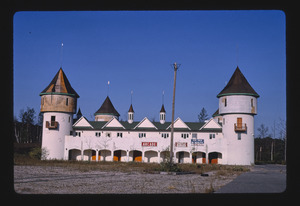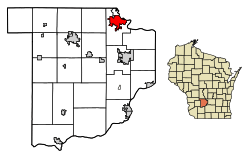Lake Delton, Wisconsin facts for kids
Quick facts for kids
Lake Delton, Wisconsin
|
|
|---|---|
|
Village
|
|

Emerald City Arcade, Lake Delton
|
|

Location of Lake Delton in Sauk County, Wisconsin.
|
|
| Country | |
| State | |
| County | Sauk |
| Area | |
| • Total | 8.12 sq mi (21.04 km2) |
| • Land | 7.49 sq mi (19.39 km2) |
| • Water | 0.64 sq mi (1.65 km2) |
| Elevation | 915 ft (279 m) |
| Population
(2020)
|
|
| • Total | 3,501 |
| • Density | 467.5/sq mi (180.5/km2) |
| Time zone | UTC-6 (Central (CST)) |
| • Summer (DST) | UTC-5 (CDT) |
| ZIP code |
53940
|
| Area code(s) | 608 |
| FIPS code | 55-41300 |
| GNIS feature ID | 1567728 |
Lake Delton is a village in Wisconsin, USA. It's located right on the Wisconsin River in Sauk County. In 2020, about 3,501 people lived there.
Lake Delton is a popular vacation spot, especially with the nearby Wisconsin Dells. It's a big center for tourism in the upper Midwest region of the United States.
Contents
History of Lake Delton
The village of Lake Delton was first called Norris. This name came from Edward Norris, who surveyed the area in 1850. Later, the village changed its name to Delton.
In 1926, the name changed again to Mirror Lake. This was to avoid confusion with the nearby Town of Delton. The name Lake Delton was finally chosen after a dam was built on Dell Creek. This dam created a reservoir (an artificial lake) that was also named Lake Delton. The village officially became a village in 1954.
The Lake Delton Flood of 2008
On June 9, 2008, something big happened to Lake Delton. The lake, which was about 267 acres (1.08 square kilometers) large, overflowed its banks. This happened after many days of very heavy rain.
The overflowing water washed away four homes and part of a road. The lake almost completely emptied into the Wisconsin River.
Geography of Lake Delton
Lake Delton is located at coordinates 43°35′48″N 89°47′16″W.
The village covers a total area of about 8.12 square miles (21.04 square kilometers). Most of this area, about 7.49 square miles (19.39 square kilometers), is land. The rest, about 0.64 square miles (1.65 square kilometers), is water.
Population and People
| Historical population | |||
|---|---|---|---|
| Census | Pop. | %± | |
| 1960 | 714 | — | |
| 1970 | 1,059 | 48.3% | |
| 1980 | 1,158 | 9.3% | |
| 1990 | 1,470 | 26.9% | |
| 2000 | 1,982 | 34.8% | |
| 2010 | 2,914 | 47.0% | |
| 2020 | 3,501 | 20.1% | |
| U.S. Decennial Census | |||
The number of people living in Lake Delton has grown over the years. In 1960, there were 714 residents. By 2020, the population had increased to 3,501 people.
2020 Population Details
In 2020, the village had 3,501 residents. The population density was about 467.5 people per square mile (180.5 people per square kilometer). There were 2,217 homes in the village.
Most of the people (69.3%) were White. About 3.1% were Black or African American, and 2.2% were Native American. About 15.3% of the population identified as being from other races. Also, 24.1% of the people were Hispanic or Latino.
2010 Population Details
In 2010, there were 2,914 people living in Lake Delton. There were 1,269 households, which means groups of people living together in one home.
About 21.4% of these households had children under 18 years old. Many households (37.9%) were married couples living together. The average age of people in the village was 36.9 years old.
Education in Lake Delton
Most students in Lake Delton attend schools in the School District of Wisconsin Dells. This district includes Lake Delton Elementary School, Spring Hill Middle School, and Wisconsin Dells High School.
A small part of Lake Delton is in the Baraboo School District. Students in this area might go to Baraboo High School. Before 1961-1962, students outside the city of Baraboo had to pay to attend Baraboo High School.
Climate
|
||||||||||||||||||||||||||||||||||||||||||||||||||||||||||||||||||||||||||||||||||||||||||||||||
Lake Delton experiences a typical Midwest climate. This means it has cold winters and warm summers. The climate chart shows the average high and low temperatures each month, along with the average rainfall.
Fun Attractions and Tourism
Lake Delton is known for its unique and fun attractions that bring many tourists.
Some of the famous sights include:
- The world's largest Trojan Horse, which is part of the Mt. Olympus Water & Theme Park.
- The world's largest artificial Pink Flamingo.
From 1952 to 2006, Lake Delton was also home to a popular attraction called The Wonder Spot.
See also
 In Spanish: Lake Delton (Wisconsin) para niños
In Spanish: Lake Delton (Wisconsin) para niños


